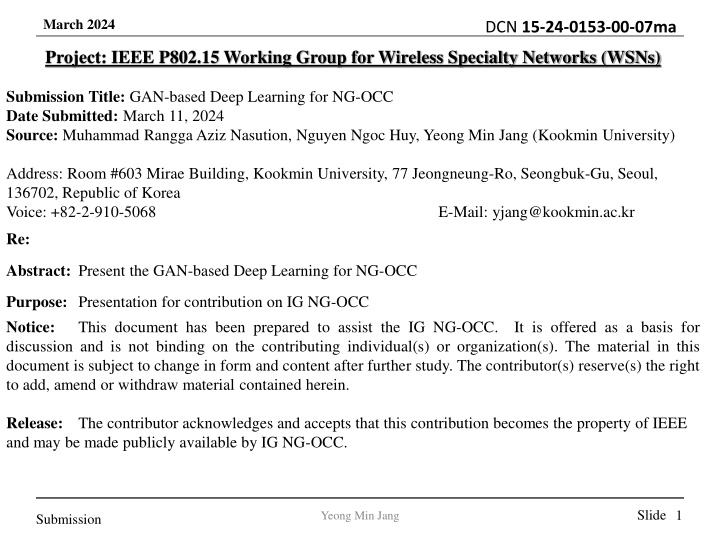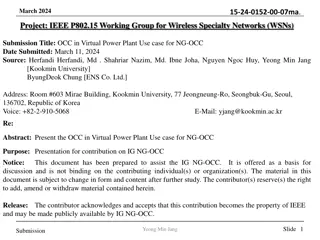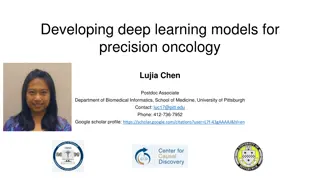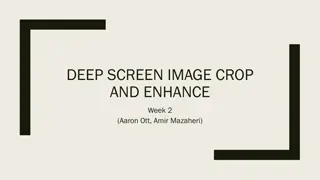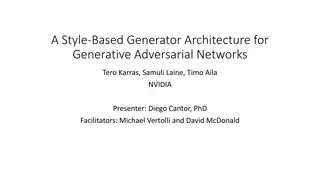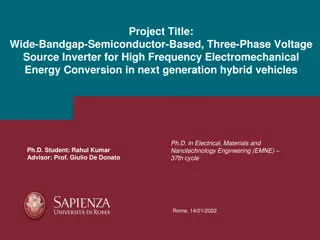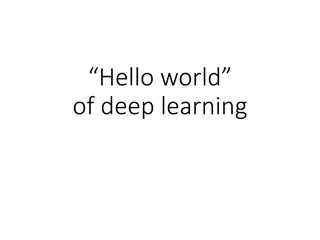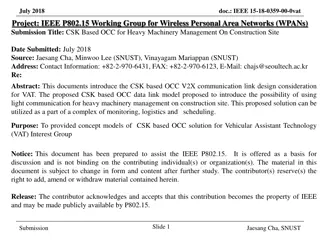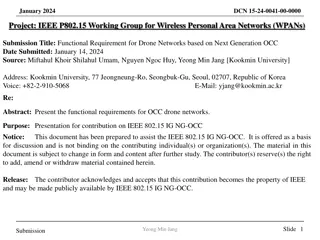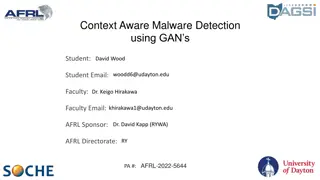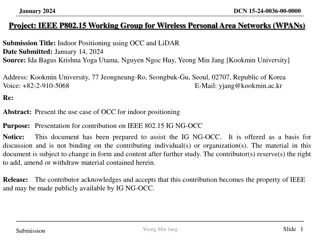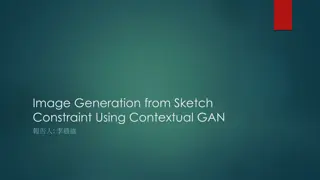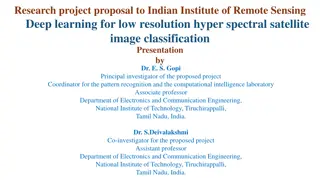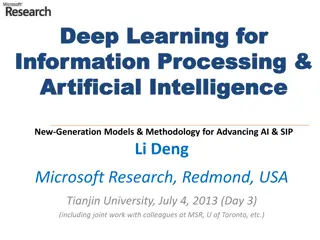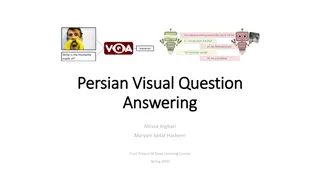GAN-based Deep Learning for NG-OCC
Artificial Intelligence has been rapidly growing, with deep learning being a highly researched field. Unsupervised deep learning, specifically GAN-based, shows promise for NG-OCC applications by extracting insights from unstructured datasets.
Download Presentation

Please find below an Image/Link to download the presentation.
The content on the website is provided AS IS for your information and personal use only. It may not be sold, licensed, or shared on other websites without obtaining consent from the author.If you encounter any issues during the download, it is possible that the publisher has removed the file from their server.
You are allowed to download the files provided on this website for personal or commercial use, subject to the condition that they are used lawfully. All files are the property of their respective owners.
The content on the website is provided AS IS for your information and personal use only. It may not be sold, licensed, or shared on other websites without obtaining consent from the author.
E N D
Presentation Transcript
March 2024 DCN 15-24-0153-00-07ma Project: IEEE P802.15 Working Group for Wireless Specialty Networks (WSNs) Submission Title: GAN-based Deep Learning for NG-OCC Date Submitted: March 11, 2024 Source: Muhammad Rangga Aziz Nasution, Nguyen Ngoc Huy, Yeong Min Jang (Kookmin University) Address: Room #603 Mirae Building, Kookmin University, 77 Jeongneung-Ro, Seongbuk-Gu, Seoul, 136702, Republic of Korea Voice: +82-2-910-5068 E-Mail: yjang@kookmin.ac.kr Re: Abstract: Present the GAN-based Deep Learning for NG-OCC Purpose: Presentation for contribution on IG NG-OCC Notice: This document has been prepared to assist the IG NG-OCC. It is offered as a basis for discussion and is not binding on the contributing individual(s) or organization(s). The material in this document is subject to change in form and content after further study. The contributor(s) reserve(s) the right to add, amend or withdraw material contained herein. Release: The contributor acknowledges and accepts that this contribution becomes the property of IEEE and may be made publicly available by IG NG-OCC. Slide 1 Yeong Min Jang Submission
March 2024 DCN 15-24-0153-00-07ma GAN-based Deep Learning for NG-OCC March 11, 2024 Slide 2 Yeong Min Jang Submission
March 2024 DCN 15-24-0153-00-07ma Contents Background GAN-based Deep Learning for NG-OCC GAN-based Deep Learning Use case in NG-OCC Conclusion Slide 3 Yeong Min Jang Submission
March 2024 DCN 15-24-0153-00-07ma Background Artificial Intelligence (AI) has been growing rapidly in recent years. The AI technology integration into many sectors has been trending topic research. The ability of AI to make its own decision based on available data is potential for automation and assistance for recently developed technology. Currently deep learning, a subset of AI, has become the most researched field. The growth of specialized AI, deep learning, not only the supervised-learning deep learning, but also the unsupervised deep learning. One of the potential unsupervised learning for NG-OCC is generative adversarial network (GAN). The versatility of unsupervised deep learning enhances its adaptability, enabling the extraction of meaningful insights from unstructured datasets. Slide 4 Yeong Min Jang Submission
March 2024 DCN 15-24-0153-00-07ma GAN-based Deep Learning GAN consists of two neural network models - a generator capturing data distribution and generating samples, and a discriminator distinguishing real from generated samples. Through a competitive training process, the generator aims to produce realistic data, and the discriminator strives to accurately identify real and fake samples. GANs, initially developed for image data generation, can be leveraged in OCC to augment limited datasets. Limited data hinders the development and application of supervised based DL models in this field. Slide 5 Yeong Min Jang Submission
March 2024 DCN 15-24-0153-00-07ma Use case in NG-OCC In OCC, obtaining labeled and diverse datasets for training deep learning models is a challenge. The need for both image data and sequential data in OCC further complicates the data collection process. GANs can contribute to improving object recognition in OCC by generating synthetic data that closely mimics the characteristics of real-world scenarios GANs' flexibility allows customization for the specific needs of OCC. By designing appropriate generators tailored to the optical characteristics and communication requirements of OCC systems, GANs can effectively contribute to overcoming data limitations and improving the overall performance of deep learning models in this domain. Slide 6 Yeong Min Jang Submission
March 2024 DCN 15-24-0153-00-07ma Conclusion Limited labeled and diverse datasets pose a significant hurdle for deep learning in optical camera communication (OCC). Diverse training data is essential for robust and generalized deep learning models in optical camera communication (OCC), reflecting real-world scenarios. Generative Adversarial Networks (GANs) offer a solution by generating realistic data, initially designed for images and extendable to diverse data types in optical camera communication (OCC). GANs' adaptability is valuable for OCC, where both image and sequential data are crucial, enhancing object recognition and overall model performance. GANs can be tailored to meet specific OCC needs, capturing optical characteristics and communication nuances, making them a versatile tool for overcoming data limitations in deep learning applications. Slide 7 Yeong Min Jang Submission
March 2024 DCN 15-24-0153-00-07ma Reference 1. Wang, D.; Zhang, M. Artificial Intelligence in Optical Communications: From Machine Learning to Deep Learning. Frontiers in Communications and Networks 2021, 2. 2. V. L. Trevisan de Souza, B. A. D. Marques, H. C. Batagelo, and J. P. Gois, A review on Generative Adversarial Networks for image generation, Comput. Graph., vol. 114, pp. 13 25, 2023. 3. E. Brophy, Z. Wang, Q. She, and T. Ward, Generative adversarial networks in time series: A systematic literature review, ACM Comput. Surv., vol. 55, no. 10, pp. 1 31, 2023. Slide 8 Yeong Min Jang Submission
